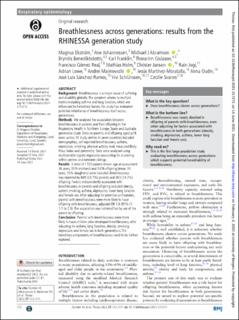Breathlessness across generations: results from the RHINESSA generation study
| dc.contributor.author | Ekström, Magnus | |
| dc.contributor.author | Johannessen, Ane | |
| dc.contributor.author | Abramson, Michael J. | |
| dc.contributor.author | Benediktsdóttir, Bryndís | |
| dc.contributor.author | Franklin, Karl A. | |
| dc.contributor.author | Gislason, Thorarinn | |
| dc.contributor.author | Real, Francisco Gomez | |
| dc.contributor.author | Holm, Mathias | |
| dc.contributor.author | Janson, Christer | |
| dc.contributor.author | Jogi, Rain | |
| dc.contributor.author | Lowe, Adrian J. | |
| dc.contributor.author | Malinovschi, Andrei | |
| dc.contributor.author | Martínez-Moratalla, Jesús | |
| dc.contributor.author | Oudin, Anna | |
| dc.contributor.author | Sánchez-Ramos, José Luis | |
| dc.contributor.author | Schlünssen, Vivi | |
| dc.contributor.author | Svanes, Cecilie | |
| dc.date.accessioned | 2022-03-01T07:26:04Z | |
| dc.date.available | 2022-03-01T07:26:04Z | |
| dc.date.created | 2022-01-27T13:50:01Z | |
| dc.date.issued | 2022 | |
| dc.identifier.issn | 0040-6376 | |
| dc.identifier.uri | https://hdl.handle.net/11250/2981904 | |
| dc.description.abstract | Background Breathlessness is a major cause of suffering and disability globally. The symptom relates to multiple factors including asthma and lung function, which are influenced by hereditary factors. No study has evaluated potential inheritance of breathlessness itself across generations. Methods We analysed the association between breathlessness in parents and their offspring in the Respiratory Health in Northern Europe, Spain and Australia generation study. Data on parents and offspring aged ≥18 years across 10 study centres in seven countries included demographics, self-reported breathlessness, asthma, depression, smoking, physical activity level, measured Body Mass Index and spirometry. Data were analysed using multivariable logistic regression accounting for clustering within centres and between siblings. Results A total of 1720 parents (mean age at assessment 36 years, 55% mothers) and 2476 offspring (mean 30 years, 55% daughters) were included. Breathlessness was reported by 809 (32.7%) parents and 363 (14.7%) offspring. Factors independently associated with breathlessness in parents and offspring included obesity, current smoking, asthma, depression, lower lung function and female sex. After adjusting for potential confounders, parents with breathlessness were more likely to have offspring with breathlessness, adjusted OR 1.8 (95% CI 1.1 to 2.9). The association was not modified by sex of the parent or offspring. Conclusion Parents with breathlessness were more likely to have children who developed breathlessness, after adjusting for asthma, lung function, obesity, smoking, depression and female sex in both generations. The hereditary components of breathlessness need to be further explored. | en_US |
| dc.language.iso | eng | en_US |
| dc.publisher | BMJ Publishing Group | en_US |
| dc.rights | Navngivelse 4.0 Internasjonal | * |
| dc.rights.uri | http://creativecommons.org/licenses/by/4.0/deed.no | * |
| dc.title | Breathlessness across generations: results from the RHINESSA generation study | en_US |
| dc.type | Journal article | en_US |
| dc.type | Peer reviewed | en_US |
| dc.description.version | publishedVersion | en_US |
| dc.rights.holder | Copyright Author(s) (or their employer(s)) 2022. | en_US |
| cristin.ispublished | true | |
| cristin.fulltext | original | |
| cristin.qualitycode | 2 | |
| dc.identifier.doi | 10.1136/thoraxjnl-2021-217271 | |
| dc.identifier.cristin | 1991394 | |
| dc.source.journal | Thorax | en_US |
| dc.source.pagenumber | 172-177 | en_US |
| dc.identifier.citation | Thorax. 2022, 77 (2), 172-177. | en_US |
| dc.source.volume | 77 | en_US |
| dc.source.issue | 2 | en_US |

